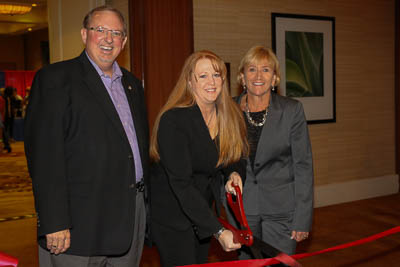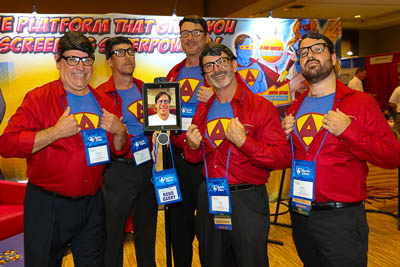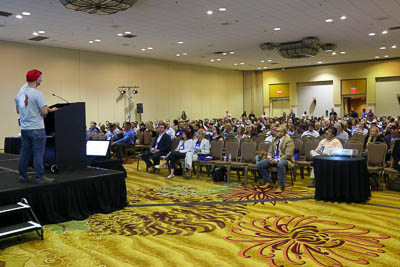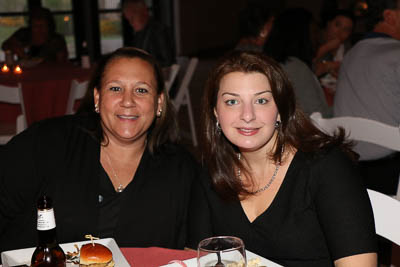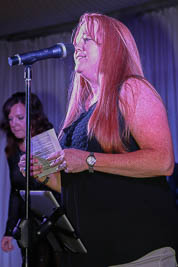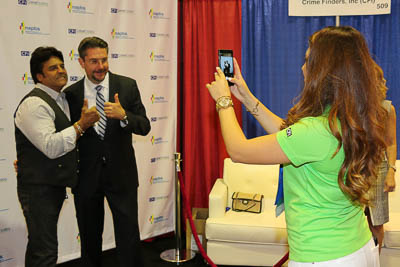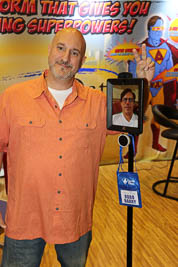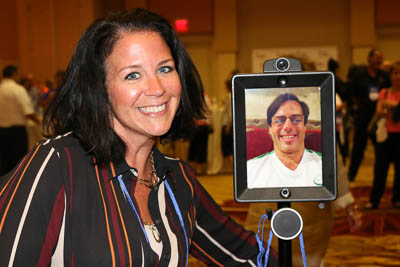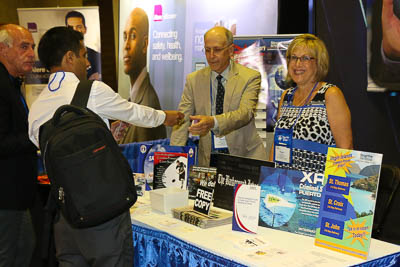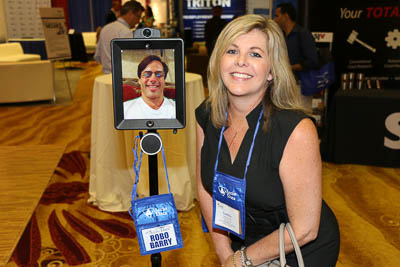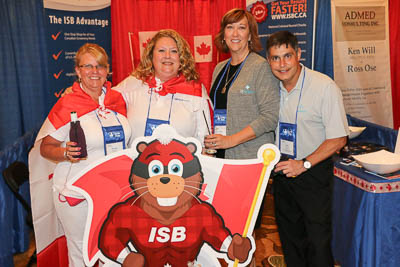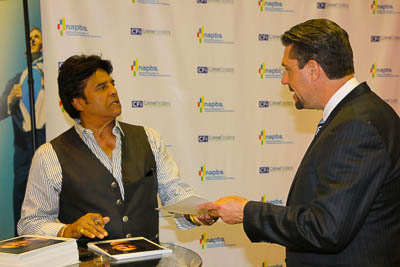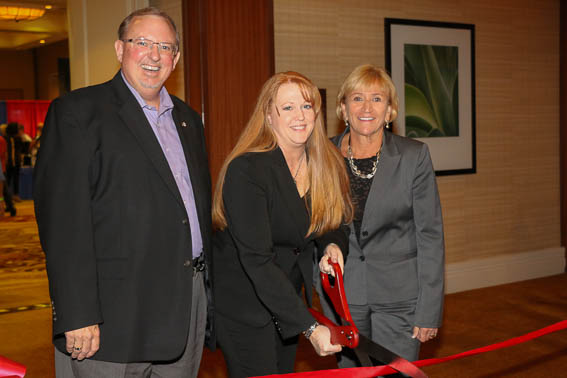 Conference takeaways:
Conference takeaways:
- Laws around the screening industry are becoming even more fragmented
- Compliance issues continue to grow in importance
- Education credentials are difficult to qualify
- Insurance and indemnification are hot topics
In this report:
- The difference between “management” and “leadership”
- How (not to) cheat on your drug test
- The biggest vulnerabilities to cyber-security
- The 4 “M’s” for growing your business
- Inside a corporate deposition
- Are education verifications worth anything?
- Top 10 legislative topics to watch
Conference Summary
The NAPBS Annual Conference was held September 18-20 in Palm Desert, CA. 763 members attended, along with exhibitors from 57 companies, making it the largest conference in the association’s history. The theme of this year’s show was “Superheroes.” About 50 golfers got a jump on things by playing in the Sue Weaver Chipping in for a Cause Tournament on Sunday morning.
Note: All speakers at the conference participated at the request of NAPBS and do not represent the official positions of their agencies or companies. Similarly, attorneys’ presentations were intended to provide general information on various regulatory and legal issues and not intended to serve as legal advice or counsel on any particular situation or circumstance.
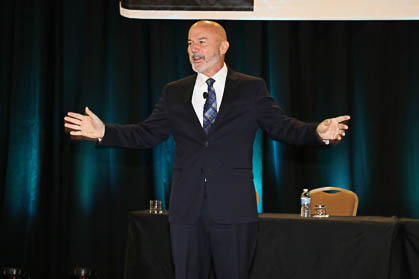 General Session – Leading the Way: Your Leadership and Our Future
General Session – Leading the Way: Your Leadership and Our Future
Executive takeaways:
- You need to drive change rather than manage it.
- You will face hiring and retention challenges as millennials enter the work force.
Speaker David Rabiner of Rabiner Resources opened Monday morning with the keynote and a challenge: “My goal today is to make you think. After I make you think, I want to make you change.”
He took the unusual step of having the audience break into groups of 3-4 to quickly discuss where they thought the screening industry would be in ten years. After reconvening, he drew a distinction between “management” and “leadership” by explaining that managers deal with change while leaders create the change. He cited examples like John Schultz (founder of Starbucks) and Apple’s Steve Jobs.
Then he told the audience to break into the same group to have the same discussion, but this time, every sentence had to begin with: “Wouldn’t it be cool if…” He asked for volunteers to shout out some of the answers and the results were interesting. Some examples:
Wouldn’t it be cool if there could be an “employment score” that you build, sort of like a credit score?
Wouldn’t be cool if people actually wanted to have their backgrounds checked and saw it as a positive thing for employment?
Wouldn’t it be cool if all courts reported the same way?
His message was that great leaders:
- Create the dream first
- Figure what they need to do to make it happen
- Start doing the daily things in line with it
He said you’ll know if you’re a good leader if you can ask your employee: “If you didn’t report to me, would you listen to me?”
He predicted near-term challenges for any business hiring millennials because they tend to not stay with any single company for long. He said that the manager of 2020 will have to renegotiate retention on a daily basis before negotiating performance.
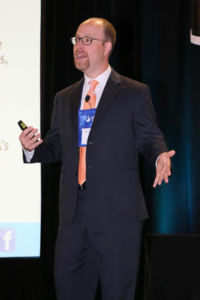 Yes, End-User Contracts Matter! So, Let’s Get Them Right!
Yes, End-User Contracts Matter! So, Let’s Get Them Right!
Executive takeaways:
- End-user contracts provide the CRA an avenue for transparency. If questions come up later, the contract is where both parties can return.
- Do not use a contract template or copy one from another CRA.
Scott Paler with DeWitt Ross & Stevens S.C. led this session focused on the importance of taking care of details in end-user contracts. He stressed that you must be aware of compliance issues in all of the jurisdictions in which you’re operating. He also noted that the indemnification section is the most discussed and argued between both parties.
Other suggestions:
- You should consider a section for Warranty Language
- Don’t forget the Limitations on Remedies section
- List Adverse Action procedures if you handle it for your clients
- Educate your clients on their responsibilities under the contract
NAPBS members can access the slide presentation here
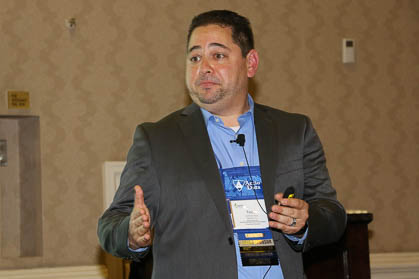 Cheating on Your Drug Test, From the User’s Point of View
Cheating on Your Drug Test, From the User’s Point of View
Executive takeaways:
- Someone trying to cheat a drug test will most likely google, “Beat a Drug Test,” bringing up millions of links.
- These sites usually don’t help on the day before because of the extended time regiment their products employ.
This session was led by Todd Shoulberg, VP of Medical Services for Clear Star Inc. He has 15 years of experience in drug testing. He said that there are common cheating methods:
Ingesting something
This usually takes days or weeks to work so employers can use the timing of drug tests as an advantage, especially with unannounced tests.
Sneaking in fake urine, submitting someone else’s urine, or adding something to their sample
Employers can combat these methods by using a lab that will follow all protocol. Doing DOT drug tests is a good method because the collection site has to actually view the applicant/ employee take the test.
Shoulberg says that when someone fails a drug test, they will try to get out of it. Some people quote sites that claim drug testing is against their 4th and 5th amendment rights (testing has not been found to violate those rights). There is an emphasis on marijuana because it is one of the few drugs that stays in the user’s system for an extended period of time. Cocaine, alcohol and several other drugs quickly get purged from the body so they are hard to test.
NAPBS members can access the slide presentation here
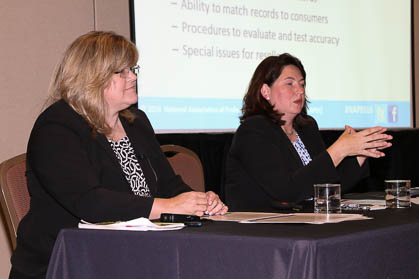 Tenant Screening Basics
Tenant Screening Basics
Executive takeaways:
- There are specific types of criminal data which may be reported under the FCRA.
Rebecca Kuehn and Jennifer Sarvadi with Hudson Cook LLP began this packed session by helping the audience to understand the basics of tenant screening, the Fair Credit Reporting Act, and what is permissible purpose.
Then the question was presented: “What is so special about tenant screening?” Throughout the session, both presenters helped the audience understand the tenant screening duties of the CRA. Each line item such as permissible purpose, contents and accuracy, disputes and identity theft, and fraud were addressed.
A key portion of this session that generated a lot of questions was the discussion of forms and authorizations. Explanations were offered discussing liability & contract issues. Accuracy and obsolescence as well as the importance of clarity and prominence generated interest from the audience.
As they wrapped up the session, they examined the differences between the CFPB and FTC enforcement differences and how they would apply to each CRA.
NAPBS members can access the slide presentation here
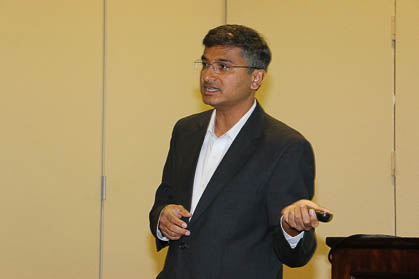 Cybersecurity: How to Thrive in a Risky New World
Cybersecurity: How to Thrive in a Risky New World
Executive takeaways:
- Data intrusions WILL occur and corporations must make it a point to balance their PDM(Prevention/Detection/Mitigation) efforts in order to be successful.
- The biggest threats to cyber security are phishing, misconfigured servers, and application vulnerabilities.
- 30% of people will give out their passwords over the phone or email.
Aurobindo Sundaram with RELX Group used graphics and stories to shed light on how big security threats can be and how fast they can happen. The session helped CRAs to protect themselves and their companies by optimizing their security programs and procedures. He cited real-world examples, including a $1-billion bank loss, JP Morgan’s ID theft of 76-million customers’ information, and a third company’s breach that is expected to cost $93-million to resolve.
The session ended by reminding the group that companies need to have layered, tighter controls on their current systems.
NAPBS members can access the slide presentation here
Four Secrets to Growing Your International Background Screening Business
Executive takeaways:
- There are 4 key points to increasing sales: market, message, media and moment.
- People are willing to pay more for value and will care less about price.
Andrew Ballard with Marketing Solutions and Ed Etzel with NetForce Global LLC led this discussion. Despite the title, this session ended up being more focused on selling in general than selling Internationally.
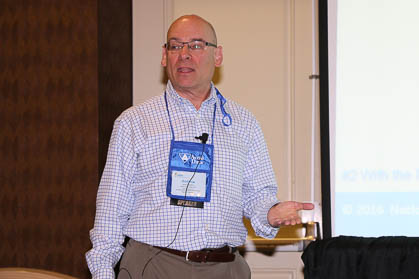 Ballard and Etzel said that 4 Keys are crucial to success.
Ballard and Etzel said that 4 Keys are crucial to success.
The Right Market
Remember the 80/20 rule: 20% of your clients produce 80% of your revenue. Don’t try to be everything to everybody. You have finite resources so you have to deploy them carefully and strategically.
The Right Message
Ask your best customers (not all of them – just the best) what motivates their purchase. What frustrates them? You have to craft the right unique value proposition and validate it across your key customers.
The Right Media
Review your communication modes (advertising, trade shows, sales calls) and your tools (audio, video, collateral materials) and see what’s working best. You also need to evaluate whether to use outbound marketing pushes (like email and direct mail) or inbound marketing pulls (like blogs, social media, articles, white papers, etc.). Infographics have become big over the last few years, but handwritten notes are still the best!
The Right Moment
When is the right moment to contact or to deliver your message? Studies show that Tuesday afternoon is the best time/day to make sales calls.
NAPBS members can access the slide presentation here
General Session – Mock Deposition
Executive takeaways:
- Litigation in the screening industry is not receding – it’s growing.
- Preparation is crucial when giving a deposition.
- Corporate depositions are very different from other depositions – the person(s) is speaking for the entire company.
Employment attorneys Pam Devata with Seyfarth Shaw and Cindy Hanson with Trautman Sanders led this entertaining session looking at depositions: what they are and how they function. They noted that in corporate representative depositions, you have to make sure you have the person most knowledgeable about the relevant aspects of your business. This is the one time in the process where legal counsel can “educate” the witness. Your counsel can discuss the “theme” of the case with the deponent. Sometimes it’s better to have an effective communicator if the subject matter expert is not.
To illustrate, they role-played two scenarios: one in which the CRA being deposed was unprepared and stumbled into a lot of traps, and another in which the CRA was able to provide documented policies, show proof that the company takes accuracy seriously and that the incorrectly reported record was the result of a single human error and not a systematic deficiency.
They cited some of the plaintiff’s attorney’s tactics:
- Being aggressive and bullying
- Establishing a rhythm for questions and answers
- Lulling you into a false sense of friendship
Devata says corporate depositions can last up to 7 hours but area usually shorter. You’ll spend the first 60-90 minutes talking about your background. She and Hanson emphasized that you must be conscientious of every moment, listen carefully to every question (and ask for clarification if there’s anything you don’t understand), always tell the truth and always come back to how important accuracy is to your company. They also said to make sure to write and update your policies, then train and re-train your analysts on them. It’s also a good idea to record when and where the training sessions took place and who attended in case you need to show it in court.
CRA/Client Compliance
Executive takeaways:
- CRAs need to verify end-user security.
- CRAs should limit documentation to meet the end-user’s actual needs.
- NAPBS accreditation is an excellent way to establish compliant procedures.
Larry Henry with Rhodes Hieronymus explored compliance issues from onboarding, client education with duties and how to understand and use reports. He suggested CRAs should supply sample disclosure and authorization forms as well as pre- and adverse action letter samples. He said CRAs should use business judgment to control risk but shouldn’t act as a dictator.
Henry said the key to accomplishing the shepherding of end users is education: providing information to end users regarding FCRA and state requirements, staying in touch with a specific contact person, and providing educational information through things like emails and webinars.
NAPBS members can access the slide presentation here
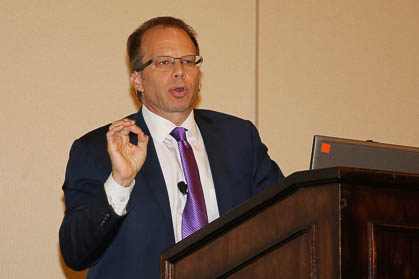 Legal Landscape for CRAs and Employers: Courts, Administrative Agencies and Legislatures Make Compliance More Challenging than Ever
Legal Landscape for CRAs and Employers: Courts, Administrative Agencies and Legislatures Make Compliance More Challenging than Ever
Executive takeaways:
- Class action filings are increasing: 150 cases in 2012 and more than 350 in 2015.
- Well-known names like Home Depot, Wells Fargo, Lowe’s, and Uber have been in court recently.
- Laws are constantly changing and varying from jurisdiction to jurisdiction.
- Courts have been split on FCRA guidelines regarding independent contractors.
This session was led by Philip Gordon and Jennifer Mora with Littler Mendelson PC, reviewing current trends in class action litigation, key new decisions impacting CRAs and employers, recent enforcement actions by the FTC and state attorneys general and key legislative developments.
The presentation concluded with some practical recommendations to mitigate the risk of pre-employment screening in an increasingly more challenging compliance environment.
- Put your operational procedures in writing
- Use a large font (12 points or more) and get rid of any extraneous text
- Capture middle name – when you have it, you may consider always using it, to prevent mistakes
- Make sure you know the difference between ‘I understand’ and ‘I authorize’
NAPBS members can access the slide presentation here
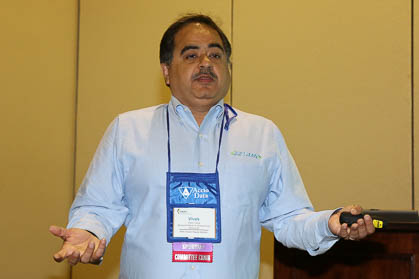 Making Verifications a Profitable Process
Making Verifications a Profitable Process
Executive takeaways:
- Verifications are a necessary evil for the CRA and demands near perfect delivery.
- Understanding your “true” costs associated with verifications are key to create the right margins for your company.
Vivek Khanna with Neeyamo Inc., and Bill Wilder with SJV & Associates LLC talked about practical ways and improvements for executing verifications.
Thoughts and ideas:
- Fish when the fishing is good (call at the right times)
- Know your clients and their sources (listen and learn)
- Retailers and food places have very different success profiles than the professionals
- Measure your success at different times for the day and line up your labor up with those times
- Use tally/tick sheets to gather data
Beyond the actual verification cost, Khanna and Wilder said things to look at when calculating your “true” costs include things like software costs, health benefits for the worker doing the verification, fax costs, voice/data costs, rent, and the number of units being completed per hour.
NAPBS members can access the slide presentation here
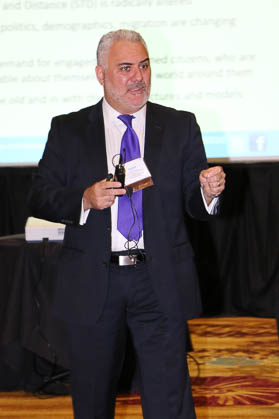 Future of Education and Verifying Credentials
Future of Education and Verifying Credentials
Executive takeaways:
- Education is a global thing; space, time, and distance have changed, having an impact on participation in education.
- Companies need a way to decide which kinds of education credentials are going to correlate to success.
This session was led by Jonell Sanches and Larry Hatch of National Student Clearinghouse. There was also a panel populated by Kerstin Bagus and Craig Caddell of ClearStar, and John Davidson with CARCO Group who were asking questions.
The panel noted some trends:
- The academic calendar (how long it takes to graduate) is stretching
- There is an unprecedented number of part-time students
- There is growth in the number of certificates and licenses
- Personalized learning is on the rise
Right now, businesses may not even be verifying education credentials because they don’t know how to assess the success rate for many differing types of education. Some companies see no evidence that verifying credentials matters at all. For example, does “some college” mean anything more than a high school diploma? The education currency right now – credit hours – is “dirty” because it doesn’t lend itself well to online certificates, learned on-the-job skills, prior knowledge, prior skills, etc.
The panel said one thing employers could do is try to match employees’ success with the kinds of credentials they had when hired. Maybe an associate’s degree is yielding the most successful employees, or having an online certificate isn’t carrying any weight. Linking experience with outcomes in the work place is a way to find the impact of certain credentials. Linking education with industry could better prepare students to become immediately productive workers by letting the industry have some say in what is important and how it should be learned.
NAPBS members can access the slide presentation here
General Session – Legislative Update
Executive takeaways:
- The presidential race will have an effect on the screening industry – we just don’t know which way.
- The association’s lobbying group tracks more than 230 pieces of legislation daily.
- New studies may be showing a different side of Ban the Box.
The conference concluded with Jamie Tucker from Akin Gump, the association’s lobbying firm. He said the question he’s asked most often is what’s going to happen with the presidential election. He admitted he doesn’t know but analysis shows Trump has a little tougher path to the Oval Office than Clinton. He said it’s a toss-up and the industry needs to prepare for both of them.
He then took a page from David Letterman’s playbook and presented NAPBS’ “Top 10 List Policy Topics”: things everyone in the industry should be watching.
#10 Salary history restrictions
This is an evolving area of the law where employers are being barred from asking applicants about salary history. It’s intended to combat gender pay discrimination.
#9 FTC
The NAPBS is having constructive engagement with the Federal Trade Commission as it continues its oversight of the screening industry.
#8 Tenant screening restrictions
Several measures are coming up which limit landlords’ ability to ask about criminal history. NAPBS is coordinating with industry ally groups to try to steer the direction of that process.
*7 CFPB
The Consumer Financial Protection Bureau (CFPB) has taken a more aggressive regulatory role but is still in the learning stages.
#6 The McCaskill investigation
In May, Senator Claire McCaskill’s office sent a letter to 21 “Specialty” CRAs seeking responses to 15 detailed questions, bypassing the CFPB. Her motives are unclear.
#5 Expungement
Record expungement continues to be a hot legislative topic. A current White House initiative includes an “expungement clearinghouse.”
#4 Ban the Box
Also a part of the broader conversation around criminal reform. Still a very strong issue but it’s been around long enough now that some studies are showing unintended consequences.
#3 Fingerprinting
Another long-term issue. The association is continuing its efforts to convince federal, state and local lawmakers that FBI fingerprinting is not the “gold standard” for screening.
#2 Records access
There are multiple challenging issues with records access such as identifiers, bulk access restrictions, and unreasonable fees.
#1 NAPBS Gold Stars
Tucker wrapped up by recognizing many NAPBS who have gotten involved in legislative advocacy at the federal, state and local levels and strongly encouraged others to join their efforts.
NAPBS will hold its 2017 Mid-Year Legislative & Regulatory Conference March 19-21, 2017.
